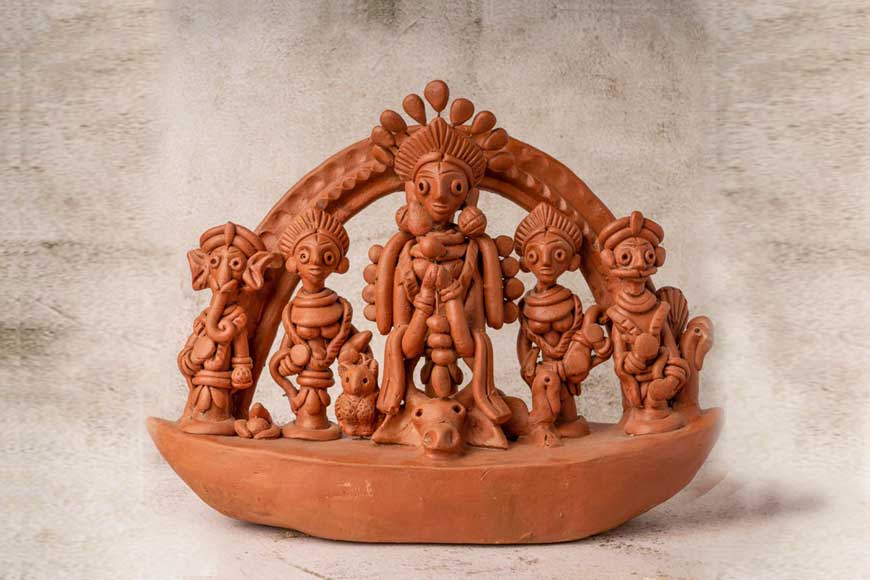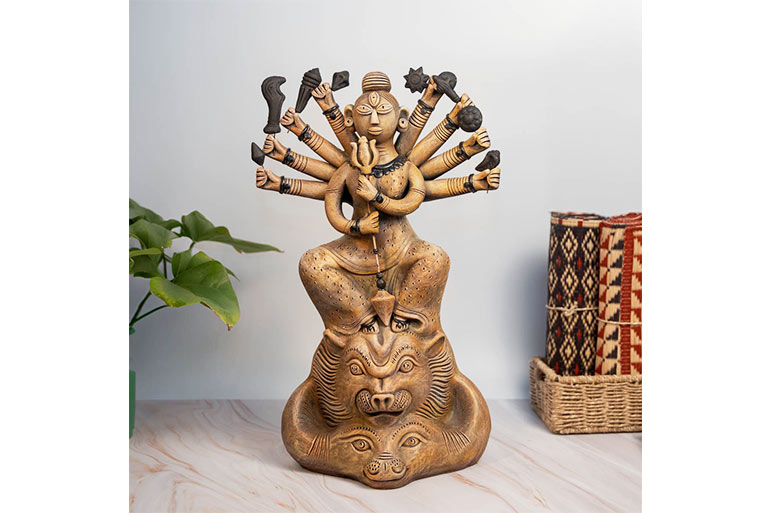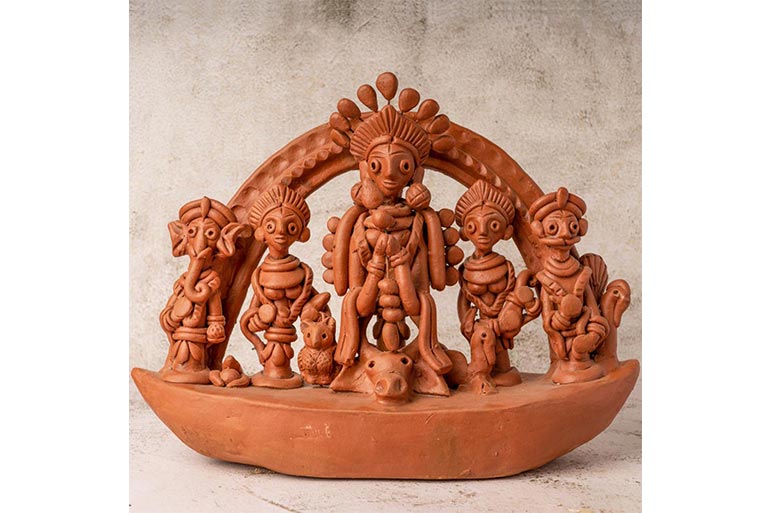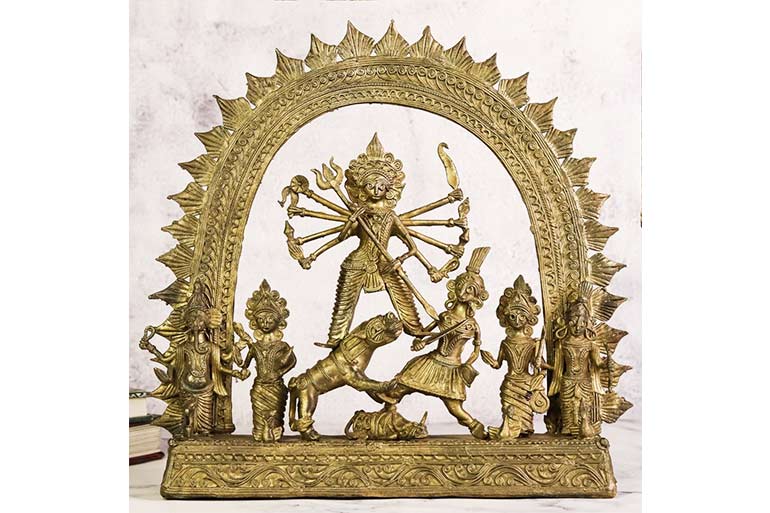Ghore Ghore Durga: The Divine Essence of Matriarchy – GetBengal story

Mother Goddess Durga channels positive energy to combat evil, thereby establishing harmony. This is why every year, the entire state of Bengal comes together to celebrate her arrival on Martyalok. As the Asuravinashini (demon slayer), she has always symbolized matriarchy. Sometimes she is portrayed as fearless, while at other times, she is depicted as a kindhearted mother figure. If we consider it from another perspective, we can envision various avatars of her within our own households, performing day-to-day chores with remarkable prowess. As women strive to secure their place in contemporary society, they find inspiration in the stories of Maa Durga as depicted in the Puranas. Artisans of Bengal have been crafting Durga motifs and idols in various mediums since time immemorial. Bengal has been an endless gallery for all types of Durga idols—be it clay, dokra, or gala (shellac).

Krishnanagar Durga
The art of clay doll making in Krishnanagar dates back 200 to 250 years. The artists here do not need institutional certificates to prove their artistic brilliance; their skill and aesthetic sense have been passed down through generations. Initially, these clay doll makers focused on crafting figurines of gods and goddesses before expanding to create other types of dolls. Kumudnath Mallik, the author of Nadia Kahini, noted that the doll makers were originally potters who specialized in making idols of deities. Later, after receiving praise from Christian missionaries and English art enthusiasts, they began making clay dolls. Krishnanagar dolls are celebrated worldwide for their unique designs, natural hues, craftsmanship, and rich history. Among these, the Ganesh Janani doll, depicting Uma (Goddess Durga as a mother) holding infant Ganesha in her arms, is particularly notable and symbolizes the age-old art tradition of Krishnanagar. Additionally, Krishnanagar Durga in her ‘Mahisasurmardini’ avatar, in both small and large forms, remains immensely popular.
Mojilpur Durga
Let us travel back about two hundred years. The Dutta Zamindars from Jashohar moved to Mojilpur, Jaynagar in South 24 Parganas and settled there permanently. Accompanying them was Kalicharan Peyada, a ‘peyada’ (security guard) of the Zamindar who possessed a unique talent for crafting beautiful dolls and divine figurines. His ‘tepa putul’ creations would mesmerize everyone. Among his two sons, Janakinath Das took up doll making. It is said that Janakinath’s son, Harinath, developed a distinctive doll-making style that later became known as ‘Mojilpur dolls’. Manmathnath, from their generation, further popularized this art form.
Currently, Shambhunath Das, the grandson of Manmathnath, is nurturing this art of doll making with great dedication. His familial house is the sole producer of these dolls in Mojilpur. The dolls are made using ‘ak khol’ and ‘du khol’ molds, with the ‘du khol’ mold allowing for higher production volumes. Completely handmade dolls are also available. Among the handmade dolls from Mojilpur, popular ones include Manikpir, Ateshwar, Dakshineswar, and Panchanan. The newest addition to their collection is Durga dolls. Previously, Mojilpur also produced Ganesh Janani dolls. Shambhunath has entrusted his creations to The Bengal Store, a hub that features his dolls along with other collections.

Terracotta Ekchala Durga
The use of certain frames like ‘chali’ and ‘chalchitra’ has always been an integral part of idol making in Shakta stream of artistry (‘Shakta’ refers to the worshippers of Goddess Shakti) in Bengal. Goddess Durga, accompanied by her children Kartik, Ganesh, Lakshmi, and Saraswati, traditionally stands in front of a ‘chalchitra,’ giving the piece a complete and harmonious appearance. Ekchala is an intrinsic part of the traditional Durga idol. Many ‘Sabeki Houses’ in Kolkata still feature this style. The traditional ‘chalchitra’ can also be found in the terracotta Durga dolls of Bankura and Bishnupur. Today, the appeal of terracotta has become universal, with small villages in the Bankura district, such as Panchmura, Sonamukhi, Rajgram, Hamirpur, and Raiganj in Uttar Dinajpur, gaining fame for their terracotta art. The artisans in these regions are renowned for bringing the terracotta Ekchala Durga to life.

Dokra Ekchala Durga
Dokra is a brass product created using the lost-wax technique of metal casting. Artifacts made with dokra hold a significant place in the history of human civilization, with some dating back to even Mohenjo-Daro. In West Bengal, Dokra artifacts are prevalent, with Bikna in Bankura and Guskara in East Bardhaman being particularly renowned for this craft. Creating Dokra artifacts is a labour-intensive process, distinguished by its intricate details, elevated artistry, and unique glow. Dokra Ekchala Durga possesses a divine aura, both artistically and aesthetically. In addition to the Ekchala Durga, Dokra artisans also create other Durga idols.
‘Ghore Ghore Durga’ is a campaign initiated by The Bengal Store that celebrates the Mother Goddess in all her splendour and the essence of matriarchy. This physical store has brought together a diverse collection of Durga idols under one roof. The address is 127 Jodhpur Park, Kolkata.










